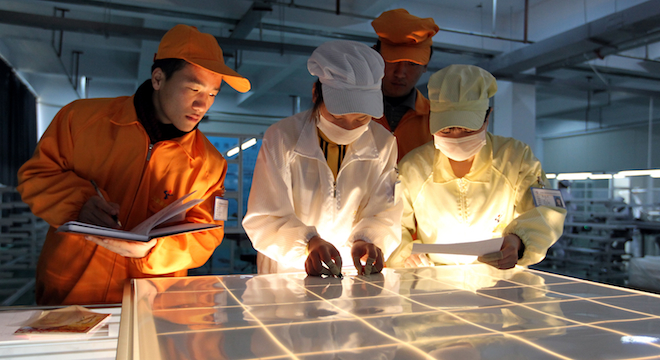The U.S. government on Tuesday slapped China with tariffs for illegally subsidizing its solar industry in a trade case that had many in the industry fearing a full-on solar trade war between the two countries.
But peace reigns for now, as the Chinese government and the companies impacted by the tariffs have taken their punishments in stride.
The relatively favorable reaction by China’s government and solar manufacturers is likely because the tariffs were far less than expected: Between 2.9 percent and 4.73 percent, depending on the specific Chinese company, compared to the 20 to 30 percent that Wall Street analysts had predicted.
“The U.S. government’s lighter than expected tariffs on China’s solar panel imports reflects some degree of rationality, but it has to do more to keep bilateral trade ties from derailing,” Chinese state media outlet New China News Agency wrote in an editorial on Wednesday (via The Los Angeles Times.)
Meanwhile, the response from Chinese companies has been similarly low-key.
“This initial decision reflects the reality that Suntech’s global success is based on free and fair competition,” read a statement by Andrew Beebe, CEO of Chinese company Suntech, the world’s single-largest solar manufacturer by sales.
“As applicable to the rest of the solar industry, this preliminary determination is only the first step, and is subject to further examination and final determination later this year,” read a statement from Jifan Gao, CEO of Trina Solar, which was hit with a 4.73 percent tariff.
But given that the U.S. Department of Commerce and the International Trade Commission are still investigating whether Chinese companies also engaged in “dumping,” (flooding the U.S. market with their low-priced panels specifically to try and kill American competitors and secure a monopoly), more tariffs could be on the way.
The Commerce Department’s preliminary decision on that case isn’t expected until May, while the ITC’s decision and the final decisions in all the cases aren’t anticipated until much later in the year.
That uncertainty has everyone in the industry holding their breath, according to Shayle Kann, a solar analyst with GTM Reseach, a clean energy market research firm.
“The expectation is that in May, when the dumping decision is revealed, that the tariffs could be much higher,” Kann told TPM in a phone interview.
Pardoxically, Kann notes that higher tariffs initially could have created more certainty. Low tariffs, by contrast “leaves uncertainty in place as to what the final numbers will be.”
“It’s too early for anyone to claim an overall victory,” Kann told TPM.
In the near term, Chinese solar panel manufacturers and their customers in the U.S., including numerous “downstream,” companies — those that install or service panels but don’t manufacture them, are breathing a tentative sigh of relief and continuing with business generally as usual. Chinese companies have also spent the past few months looking to outsource some of their production to other countries, including Taiwan and the U.S., in anticipation of the tariffs. Kann said that he had last heard that these plans were continuing as forward.
As for an earlier threat from the Chinese government to investigate claims that the U.S. government illegal subsidized exports of polysilicon — the raw material used to make most solar panels — into China, Kann said that he hadn’t heard much on that front, suggesting that China was sitting on that card, too.
“My guess is they’ll basically sit on this until they find out what the anti-dumping margin is,” Kann told TPM.
That said, the solar trade case isn’t being decided in a vacuum, and other U.S. trade cases, such as the rare earths trade case announced March 13 by President Obama, against China could quickly sour the mood between both countries.









